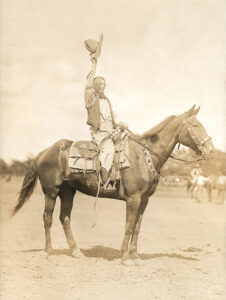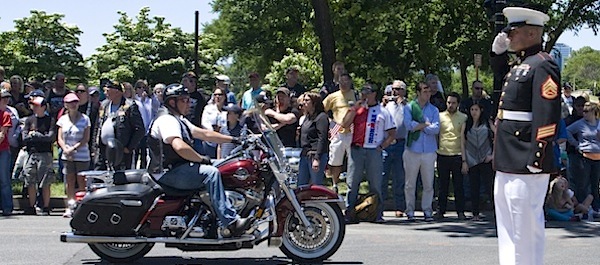
Staff Sergeant Tim Chambers during his hours-long salute, Rolling Thunder 2013, Washington, DC. Photo by Jennifer Berry, World History Group.
The first surprise in talking with United States Marine Corps Veteran Staff Sergeant Tim Chambers is how soft-spoken he is. He became known to the world as The Saluting Marine for standing at attention for hours during the Rolling Thunder event held each spring in Washington, DC, that honors veterans and raises awareness of POW/MIA issues. Holding the salute for three or four hours while standing on concrete in his Marine dress blues is demanding to say the least—grueling would be a more accurate term. One year he did it with a broken wrist, and he now performs this act to honor veterans despite a medical condition in his back.
He’s tough, yes, but when he talks his voice is soft, his sense of humor quickly becomes apparent, and he speaks with the earnestness one might expect from a minister, rabbi or other spiritual leader of the need for Americans to put aside their differences and take care of each other.
In 2012, Roger Vance, World History Group’s editor in chief interviewed Sgt. Chambers and wrote “Saga of the Saluting Marine,” published on HistoryNet in April of that year. With Rolling Thunder XXVII rapidly approaching (May 23-26, Memorial Day weekend, 2014), we thought we’d catch up with The Saluting Marine. He spoke with HistoryNet‘s senior editor, Gerald D. Swick, on April 22.
Rolling Thunder, Ride for Freedom is an annual event held in Washington, DC, to raise awareness of and bring full accountability for the Prisoners of War–Missing in Action of all wars. It is organized by Rolling Thunder, Inc., a non-profit organization. Visit their website and Facebook page for more information. Click here to read a Vietnam magazine interview with one of the founders of Rolling Thunder, Walt Sides.
HistoryNet: First off, tell us a little about Tim Chambers, not just The Saluting Marine, but who you are, what kind of environment you grew up in, what sort of things you like to do.
Tim Chambers: I grew up in Oregon, the oldest of six children. Mom had a hard time finding her soul mate. My father was a Marine in Vietnam; he came back with a lot of problems. John Chambers came into my life just as I was about to start elementary school. He was kind to us; he didn’t beat my mother. I took his name out of respect when I entered high school.
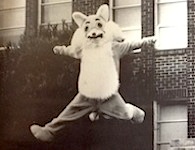 Our high school team was the Silverton Silver Foxes. I was the high school mascot, the Silver Fox. Everyone knew me as The Fox. People would see my mother, and they wouldn’t ask how Tim was doing; they asked how The Fox was doing.
Our high school team was the Silverton Silver Foxes. I was the high school mascot, the Silver Fox. Everyone knew me as The Fox. People would see my mother, and they wouldn’t ask how Tim was doing; they asked how The Fox was doing.
I was always motivated, always enthusiastic, and that carried over into the Marine Corps. Sometimes in a new unit it took time for people to realize it wasn’t a show, it’s who I am. I guess I’ve always been a sort of mascot throughout my life. I think I’m kind of a mascot for Rolling Thunder.
I like to help people. I can’t stand to see people digging in garbage cans for something to eat. You see a lot of young people who come out here to Oceanside because its warm, and it hurts me to see them digging in the garbage. I try to help them. I don’t want to be judged, I don’t judge them. Helping people—that’s kind of been my whole life.
I’ve been all over the whole country because of my salute at Rolling Thunder. It’s given me many opportunities to do things for other people, and I’m grateful to the Rolling Thunder people for that.
HN: Can you give us a couple of examples?
TC: A mother called me one time and said her son, a Marine veteran who served in Somalia had met me in Las Cruces . She told me he’d been murdered. I couldn’t afford airfare to the funeral services, and I knew my car wouldn’t make it, so I rented a motorcycle from New York Myke of San Diego Harley Davidson, who served as a Forward Air Controller in Vietnam directing air strikes for the Army’s 101st Airborne Division and drove 700 miles. I’d never driven more than 80 miles on a bike before. I ride, but I don’t have a bike—I’d like to have one, but I don’t. Anyway, I drove this bike 700 miles. Thank god for cruise control and Bob Seger.
I got to the town, put on a tie and walked into the church where the funeral was being held. I met the mother for the first time—she recognized me from the videos. After the services, I went with Stella to her house, got a few hours sleep and then drove back home, a 1,400-mile round trip.
Another time, I heard about a guy in Albuquerque an Air Force veteran, 48 years old, who had on his bucket list driving his motorcycle at Rolling Thunder past the Saluting Marine, but he’d developed stage 4 cancer and wasn’t going to be able to make it. So I traveled from San Diego to Albuquerque with my family and surprised him with a salute.
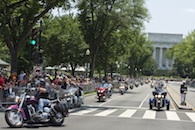 I don’t need to be active duty to make a difference. I think we can all make a difference, and we need to, to bring our country back to the center.
I don’t need to be active duty to make a difference. I think we can all make a difference, and we need to, to bring our country back to the center.
HN: You were near the Pentagon on 9/11 and rushed there to help. Would you mind talking a little about your experiences that day?
TC: I was in a meeting with my First Sergeant just up the hill from the Pentagon. I saw the plane fly over us, and within 10 seconds felt the impact. The ground shook. I didn’t know what had happened in New York, so I was completely clueless.
We went down the hill and waited until it was cleared to be safe for us to go in and search for survivors. Even in daytime it was pitch black inside. I was there for three days.
I didn’t realize the Army was in control at the Pentagon. They wanted us to leave, but all of us Marines stood our ground. Major Dan Pantaleo, author of 4 Days at the Pentagon, asked for us to be allowed to stay and said he’d make sure we were accounted for. So we got to continue rescue operations.
At end of three days I went home and slept. Before going inside the house I had to take off the white protective suit and my cammies and wash off outside. The next morning I got up, and when I went out I saw that someone had put a flag on a stake in the ground next to my gear. I’d felt kind of heavy, but that kind of uplifted my spirits; it meant a lot to me.
That’s at least part of what inspired me to go help with the victims’ families. I went down to where they were being housed, and they put me in charge of the daycare. I had all the kids low-crawling by the end of the day, and they all wanted to be Marines.
(He received the Navy Commendation Medal for his actions at the Pentagon.)
HN: How did you come to perform your first salute at Rolling Thunder, in 2002?
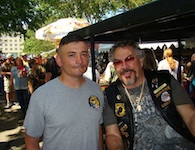 TC: I was a partner on the 50th Anniversary of the Korean War Commemoration Committee, so the year before I was at the Korean War Memorial in Washington for three days, wearing Korean War attire and educating people about the Korean War, all the countries that were involved, what it was about. It was hot and humid—I lost 10 pounds under that parka—and I was toasting people with sparkling apple cider as they walked by.
TC: I was a partner on the 50th Anniversary of the Korean War Commemoration Committee, so the year before I was at the Korean War Memorial in Washington for three days, wearing Korean War attire and educating people about the Korean War, all the countries that were involved, what it was about. It was hot and humid—I lost 10 pounds under that parka—and I was toasting people with sparkling apple cider as they walked by.
The next year, 2002, I decided I should go in my dress blues. I was going to go around, shake some hands, tell these veterans “Thank you.” Then I saw all these vets zooming by on motorcycles. I popped out and started saluting.
They just kept coming. I thought, how am I going to do this? I can’t just stop. Some of the bikers started pulling over, with tears in their eyes, as they passed by me. I felt I was touching them—in some ways, I was giving them the welcome home they hadn’t received when they came back from the war. I felt, “Wow, I have to be here next year.”
I’ve been all over the country now as the Saluting Marine. I’ve had people cry and tell me things like, “Thank you, Tim. No one ever told me I did a good job. I was dropping bombs from thousands of feet up, and all I was told when I got home was how I had killed a lot of innocent people.” There are a lot of unsung heroes (in wars) who were never properly recognized.
HN: Do you plan to be at Rolling Thunder again this year?
TC: Do you think I have an option?
HN: What are you hoping to inspire in people when you are performing this grueling salute—not just the veterans and their families, but anyone who sees you?
TC: Compassion. Respect. Common sense.
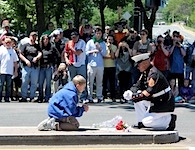 I’m doing something we as a nation should have done a long time ago. We’ve gone away from respect and common sense as a nation. We need to be helping each other, accepting each other. I want to unite Americans, no matter what network they watch on TV.
I’m doing something we as a nation should have done a long time ago. We’ve gone away from respect and common sense as a nation. We need to be helping each other, accepting each other. I want to unite Americans, no matter what network they watch on TV.
Americans need to accept the risk in their freedoms. That’s part of what I like about the bikers in Rolling Thunder. Bikers accept the risk when they ride. We all use our freedoms to make choices, and we need to accept the responsibilities for those choices. You have to accept responsibilities for your own actions. I’ve made mistakes. I don’t blame it on my father or on the fact my mother was in an abusive relationship. My choices, my mistakes, my responsibility.
HN: You contracted a serious bacterial infection following surgery in 2005 that invaded your back muscles and still flares up at times. Do you have any plans for what you might do at Rolling Thunder if you reach the point that your body simply won’t let you stand at attention for hours?
TC: I haven’t thought that far ahead, I guess. What do you think a Marine thinks? They think there’ll never be that day. I’m just blessed that I’m here and I have all my limbs. A lot of my friends don’t.
If I ever couldn’t do it, I wouldn’t feel good about it. Maybe I don’t even want to think about that. It’s sad to think there’s something wrong with me that would mean I couldn’t even do something simple. I’d let a lot of people down.
HN: Thank you for talking with us, Sergeant Chambers. Is there anything you’d like to add in closing?
TC: I will be coming out with a book. It will be a coffee-table picture book. Some amazing photographers have donated their photos of the Saluting Marine for it. It will talk about why I did the salute, what it means to people and why it is important to care about each other. I’m hoping it will reach a higher level of awareness, and bridge the gap between Americans.
For more information, visit The Saluting Marine website and Leave No Warrior Behind website.




